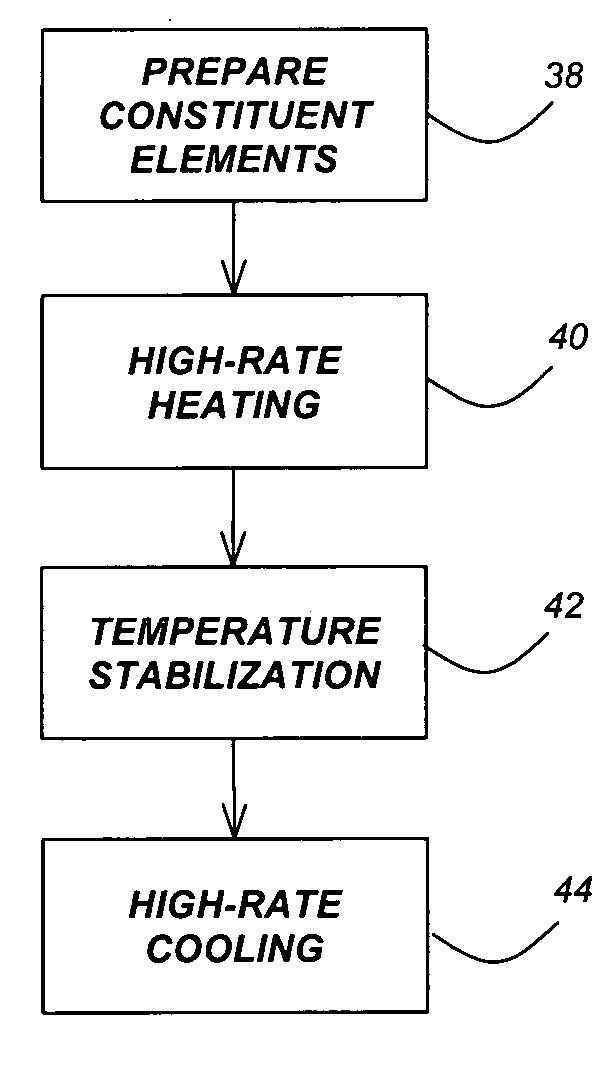Method for synthesis of colloidal nanoparticles
a colloidal nanoparticle and synthesis method technology, applied in the field of colloidal nanoparticle synthesis, can solve the problems of high temperature method imposing a limiting factor for industrial scalability and rapid discovery of nanomaterials, time and cost required for each individual reaction preparation, and low product yield for device applications, etc., to achieve reproducibility, high yield, and high yield
- Summary
- Abstract
- Description
- Claims
- Application Information
AI Technical Summary
Benefits of technology
Problems solved by technology
Method used
Image
Examples
example 1
Preparation of CdSe from a Single Source Precursor Li4[Cd10Se4(SPh)16]
[0094] It has been shown by Cumberland et al. in [7] that a novel single source precursor based upon Li4[Cd10Se4(SPh)16] in the presence of mild coordinating alkyl amine solvent can yield CdSe quantum dots in the size range of 2-9 nm with a reaction time of 720 minutes on average. Using this single source precursor in the presence of hexadecylamine (HDA) microwave irradiation yields nanoparticles in a fraction of the time.
[0095] 50 g of HDA was degassed under vacuum at 110° C. 80 mg of Li4[Cd10Se4(SPh)16] was placed in the reaction vessel and sealed with a high pressure crimp cap followed by the addition of 4 ml of molten, degassed HDA (at approximately 70° C.). The reaction vessel was placed in the chamber of the microwave reactor and irradiated with 300 Watts of power until it reached 230° C., at which time the power was decreased to 230 Watts. This power and temperature was held constant for 60 minutes. At 60 ...
example 2
Preparation of CdSe from a Single Source Precursor Li4[Cd10Se4(SPh)16] and 1-hexyl-3-methylimidazolium Chloride
[0098] The CdSe was prepared using the single source precursor Li4[Cd10Se4(SPh)16]2. A stock solution of the precursor cluster was prepared by adding 635 mg of Li4[Cd10Se4(SPh)16] and 0.0448 g of 1-hexyl-3-methylimidazolium chloride to 45 g of degassed 1-aminohexadecane at 90° C. The solution was degassed under Ar, and 5 ml aliquots were injected into the microwave reaction vials prior to the reaction. A series of reaction were performed in which the applied power was increased from 160 to 400 W keeping the reaction time at 3 minutes and the temperature fixed at 210° C. by active cooling.
[0099] An important characteristic of dielectric heating is that microscopic instantaneous temperatures can be reached with small amounts of ionic liquid. It is clear from FIG. 1 that the onset of the first exciton redshifts with increasing power. That is, the CdSe nanoparticles in the mi...
example 3
Preparation of CdSe from CdNO3 and TOP: Se.
[0100] Stock solutions of Cd and Se were prepared separately. The cation solution was prepared by dissolving 435 mg of cadmium nitrate tetrahydrate in 9.6 ml of trioctylphosphine (TOP). This solution was heated to 100° C. under vacuum for 30 minutes. The reaction mixture was purged with Ar three times and then cooled to room temperature for later use. The anion solution was prepared by mixing 182 mg of 200 mesh Se powder in 2.8 ml TOP The coordinating solvent, trioctyphosphine oxide (TOPO), was degassed under vacuum at 110° C. three times and back filled with Ar over a two hour period. The Cd (0.5 ml) and Se (0.6 ml) were mixed in a teflon sealed reaction vial, and diluted with 3.9 ml molten TOPO (approximately 65° C.) to make a 5 ml solution. The reaction vessel was placed in the chamber of the microwave reactor at room temperature. 300 Watts were applied for several seconds, at which time the temperature spiked from 40° C. to 230° C. in ...
PUM
| Property | Measurement | Unit |
|---|---|---|
| Temperature | aaaaa | aaaaa |
| Temperature | aaaaa | aaaaa |
| Cooling rate | aaaaa | aaaaa |
Abstract
Description
Claims
Application Information
 Login to View More
Login to View More - R&D
- Intellectual Property
- Life Sciences
- Materials
- Tech Scout
- Unparalleled Data Quality
- Higher Quality Content
- 60% Fewer Hallucinations
Browse by: Latest US Patents, China's latest patents, Technical Efficacy Thesaurus, Application Domain, Technology Topic, Popular Technical Reports.
© 2025 PatSnap. All rights reserved.Legal|Privacy policy|Modern Slavery Act Transparency Statement|Sitemap|About US| Contact US: help@patsnap.com



